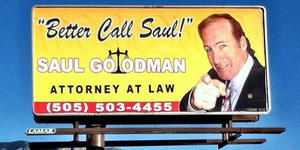 It’s probably not fair to review a new series based on half of the pilot episode, but AMC saw fit to split the pilot episode into two days, so they have nobody to blame but themselves. Plus, it is pretty clear what Better Call Saul will be like just from Part One of the two-part pilot.
It’s probably not fair to review a new series based on half of the pilot episode, but AMC saw fit to split the pilot episode into two days, so they have nobody to blame but themselves. Plus, it is pretty clear what Better Call Saul will be like just from Part One of the two-part pilot.
Better Call Saul has been billed as a spinoff of Breaking Bad, taking one comparatively minor character — hustler-lawyer Saul Goodman — and going back in time to follow his antics.
I admit to having some trepidation about the new show. My concerns were two-fold:
(1) Saul Goodman. The Breaking Bad character Saul Goodman, for those three people who didn’t see the original Breaking Bad series, is an ambulance-chasing shady lawyer who worked out of a storefront on a strip mall. The character as it appeared in Breaking Bad was largely comic relief and relatively minor (not appearing in the majority of episodes). Worse yet, he was one-dimensional. How could Breaking Bad creator Vince Gilligan hope to center a new show around that?
(2) Bob Odenkirk. Odenkirk is a very good sketch comedy writer — one of the best — having honed his craft as a writer on Saturday Night Live, The Ben Stiller Show, The Conan O’Brian Show and Mr. Show with Bob and David. He’s a fairly good sketch comedy actor as well (being the “Bob” in Mr Show with Bob and David). But he’s not a strong actor, and not even a strong character actor. He was adequate, I thought, as Saul Goodman in Breaking Bad, but the role was not very demanding or particularly leveled. Assuming that Vince Gilligan intended to round out Saul Goodman for Better Call Saul, could Odenkirk fill out that role?
There’s also the danger of being a spinoff of a wildly popular television show like Breaking Bad. Unless you get the Breaking Bad cast back — particular Bryan Cranston — you’re not cooking with the same ingredients. Even the fact that you’re putting it in the same state doesn’t matter — New Mexico in Breaking Bad is not the same as North Dakota in Fargo. So it can’t be Breaking Bad, which might disappoint Breaking Bad fans…. but if Gilligan tried to make it Breaking Bad, the end product would probably disappoint Breaking Bad fans even more.
To their credit, Vince Gilligan and co-creator Peter Gould (who actually wrote the Breaking Bad episode that first introduced Saul Goodman, late in Season Two) largely avoid those pitfalls. Although it is a dark comedy like its parent, it is clear that Better Call Saul is trying not to be Breaking Bad 2. In fact, the more it runs from Breaking Bad, the more successful it will become (I think).
The brilliance of the pilot episode lay in the writing and direction. Saul opens with a five-minute black-and-white sequence that looks like an art film. We’re in Omaha, Nebraska (my birthplace), where Saul relocated following the events of Breaking Bad. (The scene is probably an inside joke, mimicking the movie Nebraska, which also starred Odenkirk). Saul’s new identity is that of Gene, a balding, mustachioed, bespectacled sad sack manager of a mall Cinnabon. He’s also incredibly paranoid, with one eye constantly looking over his shoulder. When he gets home, he pops in a tape of one of his old in-your-face TV ads, ending with the catchy slogan, “Better Call Saul!”
The action flashes back six years prior to the events of Breaking Bad. We’re back in the familiar, colorful environs of New Mexico and Jimmy McGill (Odenkirk) is a bottom-rung lawyer begging for new clientele, whose self-described “A Law Corporation” rests in the back of an Asian nail salon. Aside from a trio of teen “knuckleheads” on trial for decapitating (and then sodomizing) a cadaver, his only real would-be client is his brother, Chuck McGill, a partner at the prestigious law firm of Hamlin, Hamlin & McGill. Chuck is on disability leave, but instead of collecting his share of the company—an estimated $17 million—he’s intent on recovering and reclaiming his former legal glory, much to Saul’s dismay.
Stylistically, Saul is a lot like the best of Breaking Bad (at least when Gilligan was directing). Cinematically, it was fantastic, with low angles, high angles, and odd perspectives (including a nice scene taking place in the moguls of a skateboard park, which made you very aware there things were not — literally — on the level). We remember a lot of the highly-charged scenes of Breaking Bad, but a lot of it was slow-paced, allowing tension to build. Saul’s opening episode reminds of this. Not every episode is going to be gunfire and explosions, and that’s a good thing.
 And Saul — er. Jimmy — is now a three-dimensional character. Still a slimy ambulance chaser, but now we see that he’s motivated by more than greed. He’s concerned about the welfare of his attorney brother, Chuck (played wonderfully by Michael McKean, who one hopes to see a lot more of). If anything, Jimmy is the inverse of Breaking Bad‘s Walter White. Walter White was a good guy plummeting into the underground world of meth-making and meth-dealing, hence Breaking BAD. With Jimmy, we see hints of the inverse — a con man lawyer trying to do the right thing (at least where is brother is concerned). Could this be Breaking Good? Walter White and Jesse Pinkman were, depending on where you go in the timeline, anti-heroes — it was uncomfortable if not impossible to root for them as drug dealers and/or sociopathic killers. By contrast, Odenkirks’s Saul, sleazy as he might have been in Breaking Bad, at least had his limits — a man who kept himself a safe distance from the actual drugs and blood. That alone might make for a better anti-hero — more convincing and compelling — particularly if, as Jimmy McGill in 2008, a lot of his motivation is justice for his brother. Yeah, he’ll screw it up — after all, incompetence is at the core of Gilligan’s brand of dark humor.
And Saul — er. Jimmy — is now a three-dimensional character. Still a slimy ambulance chaser, but now we see that he’s motivated by more than greed. He’s concerned about the welfare of his attorney brother, Chuck (played wonderfully by Michael McKean, who one hopes to see a lot more of). If anything, Jimmy is the inverse of Breaking Bad‘s Walter White. Walter White was a good guy plummeting into the underground world of meth-making and meth-dealing, hence Breaking BAD. With Jimmy, we see hints of the inverse — a con man lawyer trying to do the right thing (at least where is brother is concerned). Could this be Breaking Good? Walter White and Jesse Pinkman were, depending on where you go in the timeline, anti-heroes — it was uncomfortable if not impossible to root for them as drug dealers and/or sociopathic killers. By contrast, Odenkirks’s Saul, sleazy as he might have been in Breaking Bad, at least had his limits — a man who kept himself a safe distance from the actual drugs and blood. That alone might make for a better anti-hero — more convincing and compelling — particularly if, as Jimmy McGill in 2008, a lot of his motivation is justice for his brother. Yeah, he’ll screw it up — after all, incompetence is at the core of Gilligan’s brand of dark humor.
Odenkirk steps up to the increased demands of his character, Jimmy McGill. He already had a manic, depressed, negative energy to Jimmy/Saul and has great comic appeal (like a scene where he sees a long conference room desk and launches into a Ned Beatty from Network impersonation). But, more importantly, Odenkirk was able to muster a little depth, particularly in the scenes with McKean. I don’t think in the seasons to come (Saul has already been greenlighted for Season Two), he’ll be called on to do some, you know, heavy acting, and I doubt we’ll see him walk away with a lot of awards a la Cranston…. but that said, Odenkirk was able to deliver (so far). Perhaps that is because Saul/Jimmy, even in fleshed out form, isn’t all the complicated, although his dilemnas might be. For me, the jury is still out on Odenkirk, but I’m cautiously optimistic now.
The easter eggs and other gifts to Breaking Bad fans are fun (“Oh, look, it’s Mike as a parking garage attendant!” “Oh, that’s Tuco – remember him?” “Hey, isn’t that the same cafe where…..”) and maybe necessary to get Breaking Bad fans to tune in. But they seemed a little heavy-handed, and will probably become a distraction before too long. Again, Saul needs to find its own footing, and not ride on Bad‘s coattails or rely on Bad crossover links, even as easter eggs. Hopefully, Gilligan understands this.
But so far — and again, we’re talking about only the first half of the pilot episode — the strength of Better Call Saul lies behind the camera, with the writing and direction. That will set it above the many other fine shows out there, even in this “Second Golden Age of Television”. One hopes that Gilligan and Gould will continue to nurture this show (Gilligan also has his hands in a new ABC show called “Battle Creek” so his time may be divided). My understanding is that the second half of Saul’s pilot episode is frantic and crazy– in contrast to the deliberate slow boil of the the first half. That should be interesting. But I, like many, will be watching.
UPDATE (the next day): After seeing the second part of the pilot I don’t have much to add, except that I’m becoming more convinced of Odenkirk’s acting skills. The second part was not as frantic as I was led to believe, but it certainly wasn’t a slow boil either. And it won me over for two simple reasons:
(1) A wonderful tribute to “All The Jazz” one of my favorite movies. It was basically a repeated montage of Saul doing what Saul does as a public defender, done to the strings of Vivaldi, and ending with him clapping and looking in the mirror — “it’s showtime, folks”. Like Roy Schieder as Fosse does here:
(2) The introduction of a new character played by Michael Mando — who was so wonderful (and evil) as Vic (Sarah’s ex-boyfriend) in Orphan Black

